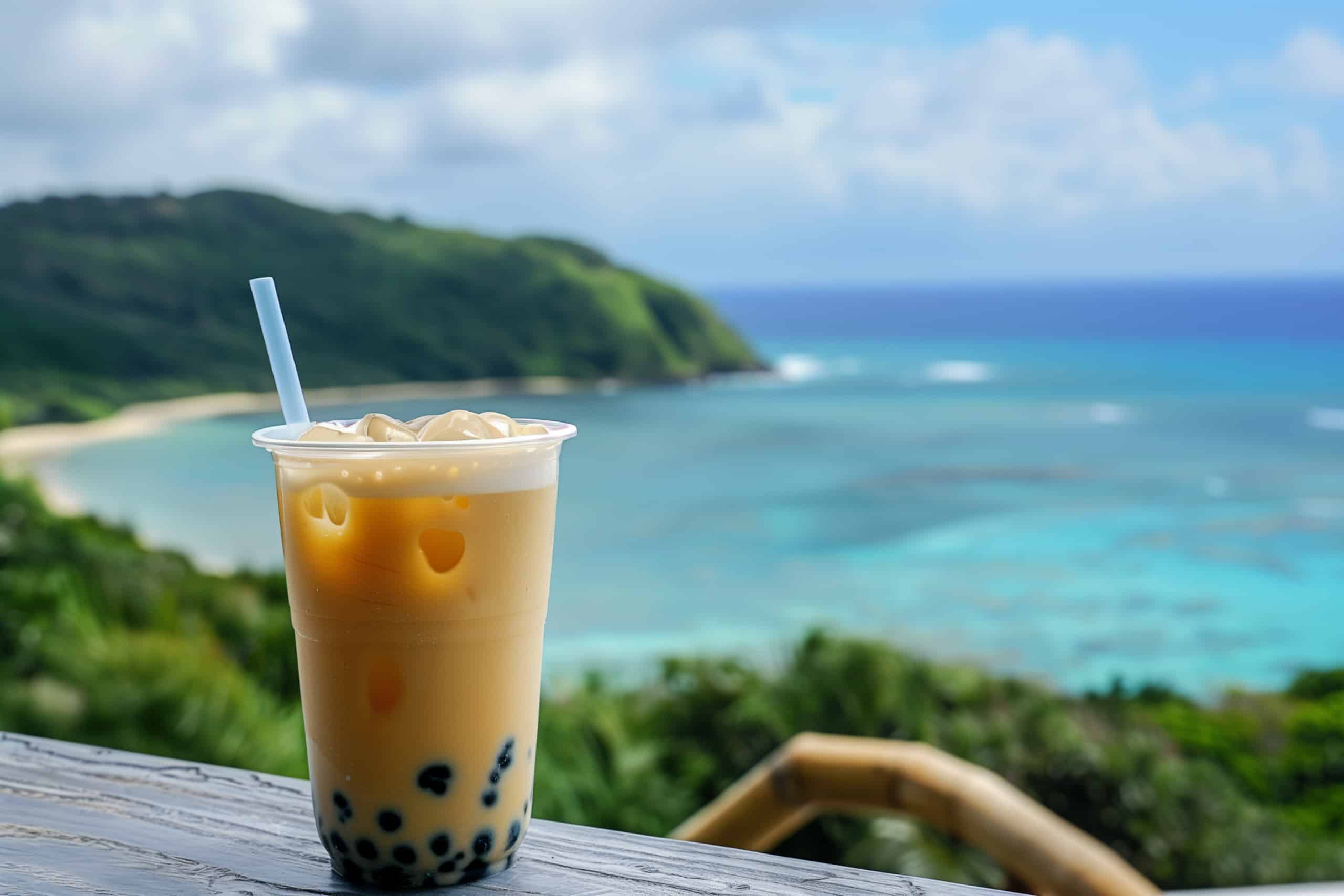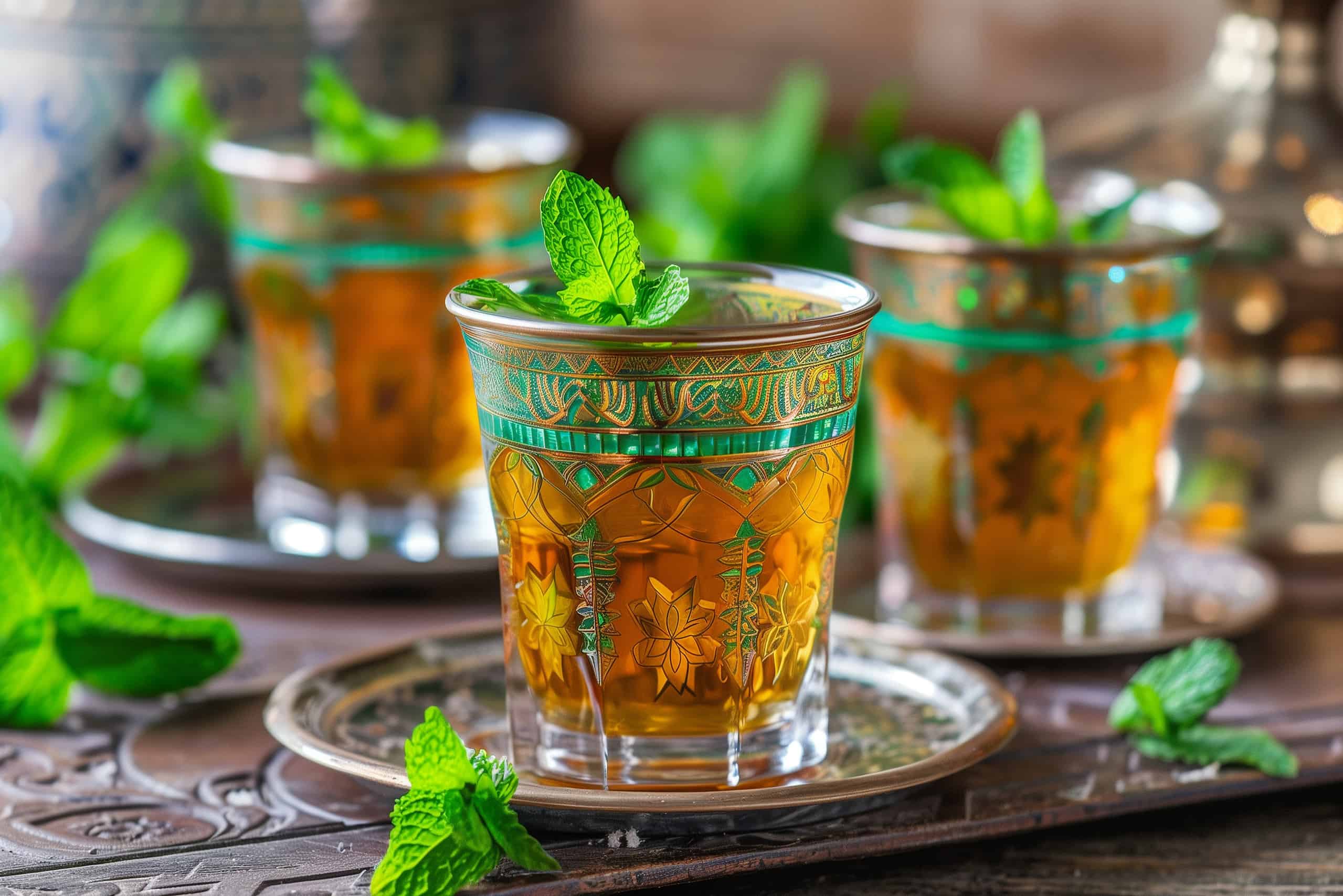1. What is Okinawa Milk Tea?
Okinawa Milk Tea stands out with its signature use of kokuto, brown sugar from Okinawa, a cluster of islands in Japan. This unrefined sugar imparts a rich, caramel-like sweetness with hints of molasses. A strong black tea, often Assam, provides a bold base that balances the sugar. Milk adds creaminess.
Preparation is simple, the sugar dissolves in the hot tea, then milk is added. The drink is enjoyed hot or cold, often as a bubble tea with tapioca pearls, or “boba”, for added texture.
Rooted in Okinawa’s reputation for longevity and healthy living, Okinawa Milk Tea has gained popularity not only across Japan but also worldwide. Variations exist in the sweetness level, type of black tea used, and the potential addition of spices or other flavorings.
What is kokuto?
Kokuto is unrefined sugar produced from sugarcane grown in the rich, volcanic soil of the Japanese Okinawa islands. The production process involves minimal processing, retaining more of the natural molasses content and nutrients, such as potassium, calcium, iron and other minerals. This imparts a deep, complex sweetness reminiscent of caramel and a slight mineral taste. The flavor complexity and nutrient density set it apart from other sugars.
While it has gained attention for its use in Okinawa Milk Tea, kokuto has a long history within Okinawa’s culinary scene. For example, you’ll find it in traditional sweets like kokuto manju, which combines kokuto and sweet red bean paste called azuki.
2. Why is it called Okinawa Milk Tea?
The name “Okinawa Milk Tea” directly references its origin in the Okinawa prefecture of Japan. This group of islands is known for both longevity and distinct cultural practices. The name emerged as this tea’s popularity spread beyond its birthplace, highlighting it as a unique regional drink.
There aren’t widely used alternative names in English, but in Japan, you might find it called “Okinawa Black Sugar Milk Tea” to emphasize the key ingredient. Sometimes, it’s affectionately grouped under the broader terms “boba tea” or “bubble tea,” due to its similarity to other popular milk tea beverages that often include tapioca pearls.
3. Flavor Profile
The unique and indulgent flavor profile of Okinawa Milk Tea is characterized by a deep, caramel-like sweetness from Okinawan brown sugar, kokuto, that also offers hints of molasses and a subtle earthiness. This complex sweetness is balanced with the slight astringency and robustness of black tea. The milk adds a creamy, velvety layer to the tea, enhancing its mouthfeel and overall sensory experience, creating a well-rounded beverage. The texture is smooth, with a potential chewy element if tapioca pearls (boba) are added to create a bubble tea.
The specific type of black tea, the amount of kokuto sugar used, and the milk choice all impact the final taste. A spicier variation, although much less common, might include hints of warming spices like vanilla, ginger or cinnamon.
The aroma of Okinawa Milk Tea is as inviting as its taste, with notes of molasses from the brown sugar mingling with the earthy undertones of the tea. The interplay of these components—the sweet, complex notes of kokuto sugar, the boldness of black tea, and the creaminess of the milk—results in a beverage that is not only a treat for the taste buds but also a multisensory experience.
4. Ingredients
The essential ingredients in Okinawa Milk Tea include robust black tea, distinctive Okinawan brown sugar kokuto, and creamy milk.
- Sweetener: Okinawan brown sugar (kokuto) is the defining ingredient. Its unique caramel and molasses notes are difficult to replicate with other sweeteners.
- Tea: Traditionally, a strong black tea like Assam is used to stand up to the sweetness. Its boldness and slight astringency are essential for balance.
- Milk: While optional, milk adds richness and creaminess. Whole milk is common, but plant-based options like oat, almond or soy milk work well too.
- Flavorings: While not strictly traditional, some modern variations incorporate spices and other flavorings. For example, vanilla or warming notes like ginger or cinnamon complement the tea and sugar beautifully.
- Boba: Tapioca pearls are often added, providing a chewy contrast to the drink’s creamy texture.
5. Recipe for Okinawa Milk Tea
Tools:
Crafting Okinawa Milk Tea requires a few basic tools:
- Pot for brewing tea
- Measuring cups
- Strainer
- Serving glass
- Straw (optional, for bubble tea)
Ingredients:
For a single (1) serving, you’ll need:
- 240 ml (8 oz) water
- 15-20 g (1-1.5 tbsp) black tea leaves, or 2 tea bags (strong, such as Assam)
- 30-45 ml (1-1.5 oz) Okinawan kokuto brown sugar syrup (adjust to taste)
- 60 ml (2 oz) milk (full-fat)
- Ice cubes (optional for a cold version)
- Tapioca pearls (optional for bubble tea)
Instructions:
- Brew black tea: Boil water and steep the tea leaves or bags for 3-5 minutes, depending on desired strength. Remove leaves or bags.
- Make sugar syrup: Prepare the brown sugar syrup by dissolving Okinawan brown sugar in a small amount of hot water, creating a rich syrup.
- Pour syrup into glass: Pour the brown sugar syrup into the serving glass, adjusting the quantity to your sweetness preference.
- Add ice: Place ice cubes into the glass if you’re making a cold version.
- Add tea: Pour the brewed tea into the glass, leaving room for milk.
- Add milk: Top with milk, stirring gently to create a gradient effect.
- Add boba: For an added texture, include cooked tapioca pearls at the bottom of the glass.
6. Tips & Troubleshooting
Here are my top 10 tips that will help you avoid the most common mistakes when making Okinawa Milk Tea:
- Avoid Overbrewing: Steep black tea for 3-5 minutes. Overbrewing can result in bitterness.
- Adjust Sweetness: Start with less Okinawan brown sugar syrup and adjust to taste to avoid excessive sweetness.
- Syrup Consistency: Ensure the brown sugar syrup is neither too thick nor too thin for the right flavor balance.
- Milk Selection: Full-fat milk enhances creaminess, but alternatives like almond or soy milk are suitable for dietary preferences.
- Water Temperature: Use boiling water (just below 100°C or 212°F) for black tea to fully extract its flavors.
- Tea Quality: Loose leaf tea often offers a richer taste than tea bags, but ensure it’s of good quality.
- Serving Temperature: For iced tea, ensure it’s chilled enough by using plenty of ice.
- Tapioca Pearls: If using boba, cook until soft yet chewy, and don’t let them sit too long to avoid hardening.
- Customization: Feel free to adjust ingredient ratios or add flavorings to suit your taste.
- Stirring Technique: Stir gently when adding milk to create a beautiful gradient effect.
7. Serving
Okinawa Milk Tea is traditionally served both hot and cold, making it versatile for any season. Modern presentations often feature clear glasses to showcase its beautiful gradient, with wide straws for tapioca pearls. Traditional teaware like ceramic cups can be used for a hot serving. Ideal for cafes and casual gatherings, it’s suitable for daily enjoyment.
8. History & popularity
Okinawa Milk Tea’s origins are linked to the health-conscious traditions of Okinawa, where it was enjoyed for its perceived wellness benefits. Its popularity steadily grew throughout Japan before finding wider appeal globally as part of the broader rise of bubble tea and similar milk tea beverages.
Traditionally, Okinawa Milk Tea is a comforting daily beverage enjoyed both hot and cold. Its presence extends from casual home settings to social occasions and hospitality. The tea’s increasing availability in cafes and restaurants highlights its mainstream appeal within Japan. Globally, Okinawa Milk Tea is primarily found in establishments specializing in bubble tea or Asian-inspired drinks. Its signature flavor offers a distinct alternative to other popular milk tea varieties, appealing to those seeking a unique and richly flavored experience.
9. Other similar teas
Here are a few other teas that share some characteristics with Okinawa Milk Tea, such as the use of milk and the option for sweetness and tapioca pearls, yet they each offer distinct flavors and cultural origins.
- Japanese Royal Milk Tea: Made with a high ratio of milk to water and often using premium black tea leaves, Japanese Royal Milk Tea is known for its rich, smooth flavor, similar in creaminess to Okinawa Milk Tea but without the distinct caramel sweetness of Okinawan brown sugar.
- Hokkaido Milk Tea: Known for its use of rich, creamy milk from Hokkaido, this tea emphasizes a luxurious texture and a mild, sweet flavor, distinct from Okinawa Milk Tea primarily due to its lack of the signature Okinawan brown sugar, resulting in a creamier, less molasses-like sweetness.
- Taiwanese Bubble Tea: Originating from Taiwan, this beverage shares the inclusion of tapioca pearls and can be customized with various flavors, differing in its broader range of base teas and sweeteners.
- Hong Kong Milk Tea: Known for its signature smooth, silky texture from the use of evaporated or condensed milk and a characteristic straining process using a stocking-like filter, which differentiate it from the Japanese Royal Milk Tea.


